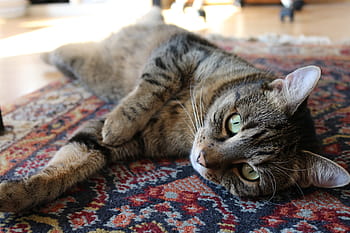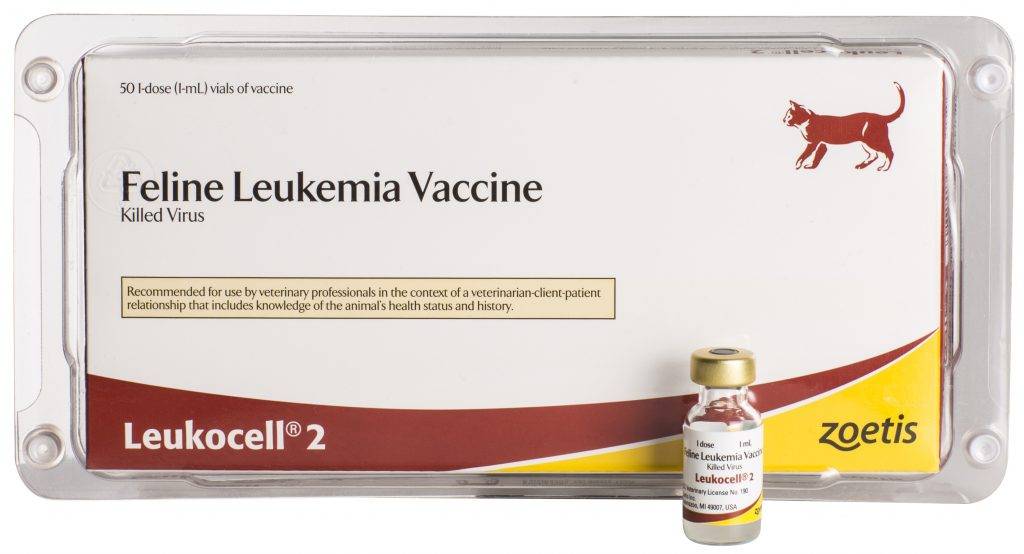A common infectious disease in cats is feline leukemia virus or FeLV. This week I’m sharing information about this important condition because I believe it’s important for all cat owners to be familiar with it. I hope you find the post helpful and will consider sharing with other cats lovers. Happy reading!

What is feline leukemia virus?
Feline leukemia virus is a retrovirus that belongs to the oncornavirus family. This retrovirus contains a single strand of ribonucleic acid or RNA. From the RNA, complimentary deoxyribonucleic acid (cDNA) is made via a special enzyme called reverse transcriptase. This cDNA – now called a provirus – is inserted and integrated in a cat’s own DNA to cause disease.

There are multiple subgroups of FeLV, specifically subgroup A, subgroup B, and subgroup C. Only subgroup A is transmitted from cat to cat. Furthermore, all naturally-infected cats are infected with subgroup A, but may be co-infected with subgroup B and/or C.
How does a cat get FeLV?
Feline leukemia virus most commonly transmitted via contact with saliva from infected cats. The virus is also shed in blood, urine, feces, nasal secretions, and milk. There are six stages of FeLV infection:
- Stage I (Initial Infection) – The virus replicates in local lymphoid tissue, typically in the oropharynx (aka back of the throat). Cats that are able to mount an effective immune response eliminate the virus at this point and are called “regressor cats” because they develop high levels of neutralizing antibodies and never develop clinical signs of disease.
- Stage II (Primary Viremia) – When cats are unable to mount an effective initial immune response, the virus spreads via the bloodstream in white blood cells (e.g.: lymphocytes, monocytes).
- Stage III (Virus Amplification) – The virus amplifies during this face, infiltrating other tissues like the spleen, thymus, gastrointestinal tract, and lymph nodes. Occasionally cats are able to mount enough of an immune response to still clear infection at this stage.
- Stage IV (Established Infection) – The virus infects the bone marrow. Cats cannot eliminate the virus once the bone marrow is infected because the provirus / cDNA has been inserted into bone marrow stem cells.
- Stage V (Bone Marrow Release) – The bone marrow releases infected cells likely granulocytes and platelets into circulation.
- Stage VI (Dissemination) – Epithelial cells throughout the body are infected, and virus is shed from tissues like the tear glands, urinary bladder, and salivary glands.

Occasionally cats in stage IV don’t develop disease because – for some reason – they don’t actively produce viral particles. These cats don’t have detectable virus in their blood, they don’t shed the virus, and they are not infectious to other cats. This phenomenon is called a latent infection. Latently infected cats do not test positive on traditional blood tests; they only test positive when bone marrow samples are tested.
Some cats chronically have viral particles circulating in their bloodstreams, and the virus perpetually replicates in various tissues and organs. This phenomenon is called persistent viremia, and affected cats often develop co-morbid conditions.
What does FeLV look like?
There is no breed predilection to feline leukemia, but male cats are over-represented. Juvenile and geriatric cats appear to have a predilection for infection. The virus can cause a wide variety of disorders in cats, and clinical signs can vary widely. Common associated diseases with FeLV are:
- Blood-borne Diseases – Red blood cell, platelet, and white blood cell disorders are commonly reported in patients with FeLV infection
- Secondary Infections – FeLV infection suppresses the immune system, and other infectious agents can easily take advantage. Common opportunistic infections are feline infectious peritonitis, hemotropic mycoplasmosis, and upper respiratory disorders.
- Immune-Mediated Diseases – the immune system may react inappropriately to cause problems in the kidneys (called glomerulonephritis), in joints (called polyarthritis), and in red blood cells (called immune-mediated hemolytic anemia).
- Cancer – Leukemia and lymphoma are the most common cancers associated with FeLV infection in cats. In our feline friends, lymphoma can affect different areas of the body, and multicentric and mediastinal lymphoma are most frequently found in FeLV-positive cats. Our feline friends with mediastinal lymphoma may have breathing difficulty, coughing, regurgitation, and Horner’s syndrome. Occasionally, other tumors – for example, fibrosarcomas and osteochondromas – have been associated with FeLV infection.
- Neurologic Problems – Feline leukemia virus has direct toxic effects on brain tissue. Alternatively, lymphoma associated with FeLV infection can infiltrate the brain and/or spinal cord. Affected patients may be weak or paralyzed, develop vision loss, have unequal pupils (called anisocoria), and vocalize inappropriately.
- Intestinal & Liver Diseases – Viral particles can invade gastrointestinal and/or liver cells to cause clinical signs like weight loss, vomiting, diarrhea, and/or loss of appetite.
- Reproductive Disorders – Pregnant queens may spontaneously abort.
- Dental Health Issues – Infection with FeLV may cause inflammation in mouth (stomatitis) and around the teeth (periodontitis)
How is it diagnosed?
There are multiple tests available to screen cats for feline leukemia virus infection, including:
- Soluble Antigen Tests – Veterinarians can readily perform soluble antigen testing in hospital. These tests detect a viral protein called p27 in blood, and are positive in cats during primary viremia. In other words, this type of test is positive before the virus infects the bone marrow. Cats who test positive via a soluble antigen test may revert to negative status if they’re able to mount a robust enough immune response or they may develop persistent viremia. Felines that test positive via a soluble antigen test should have the test repeated four months later, as cats that have a persistently positive result at that are most likely persistently viremic. Cats with latent FeLV infections will test negative via soluble antigen tests because virus is not being actively produced.
- Immunofluorescent Antibody Testing – This test also detects the p27 antigen, but only becomes positive once the bone marrow is infected. This type of test is most commonly used to confirm a positive soluble antigen test. Cats with latent FeLV infections will test negative via soluble antigen tests because virus is not being actively produced.
- Polymerase Chain Reaction (PCR) – This type of test detects nucleic acid from the leukemia virus. Polymerase chain reaction tests are not accurate when performed on blood, but are ideal for bone marrow and lymph node samples. The type of test can be used to detect latent infections.
- Virus Isolation – Viral particles can be grown in cell culture. However, this type of test is not routinely performed given the other newer detection methods.

If a cat tests positive for feline leukemia virus, veterinarians will recommend additional testing to screen for FeLV-associated diseases described earlier. The specific tests recommended will vary depending on a patient’s clinical signs, and may include:
- Complete Blood Count – to evaluate red blood cells, white blood cells, and platelets
- Biochemical Profile – to evaluate liver and kidney function, as electrolytes like sodium and potassium
- Urinalysis – to help evaluate kidney function and screen for urinary tract infections and protein-losing kidney disease like glomerulonephritis
- Diagnostic Imaging – radiographs (x-rays) of the chest and abdomen, as well as abdominal ultrasonography can be helpful to screen for evidence of cancer
- Lymph Node Sampling – aspirating or performing a biopsy on an enlarged lymph node is a minimally-invasive test used to screen for cancer
- Bone Marrow Sampling – this minimally-invasive test may be recommended to look for FeLV in this location, as well as to screen for causes of red blood cell, white blood cell, and/or platelet problems like cancer
How is FeLV treated?
Some therapeutic interventions are available to treat cats infected with feline leukemia virus. Specific therapies include:
Zidovudine (AZT) – This drug blocks the enzyme called reverse transcriptase in retroviruses and can inhibit new cellular infection. Unfortunately, this drug has not consistently caused improvement in clinical signs or laboratory parameters.
Interferons – Two interferons are available – human interferon-alpha and feline interferon-omega. These drugs can inhibit viral replication, and can decrease the concentration of p27 antigen. Unfortunately, many cats become refractory to human interferon-alpha after 1-2 months of treatment. Studies investigating feline interferon-omega have had mixed results. One study documented no improvement in viremia while another showed the drug improved survival time.

In addition to antiviral therapy, many cats infected with feline leukemia virus need supportive care. Veterinarians should treat any FeLV-associated disease. Medications to promote red blood cell and/or white blood cell production by the bone marrow may be needed. Cat owners may find it helpful to partner with a board-certified veterinary internal medicine specialist to develop a logical and cost-effective treatment plan for their infected cats.
What the prognosis for a cat with FeLV?
The median survival time for cats living with feline leukemia virus has been reported to be 2.4 years. With appropriate care, many FeLV-infected cats can live for several years. Cats with latent infections may never develop clinical signs and may live healthy lives with a normal lifespan. Here are some important points to help FeLV-infected cats live their fullest lives:
- Routine evaluations by a veterinarian are important
- Infected cats should be evaluated by a primary care veterinarian at least every six months. Blood and urine tests should also be checked twice a year.
- Control heartworm, fleas, ticks, and intestinal parasites
- Infected cats should receive appropriate year-round parasite control
- House them indoors
- Infected cats should not be allowed to roam outdoors
- Avoid raw meat diets
- FeLV-infected cats are prone to opportunistic infections that may be readily transmitted via feeding raw meat.
- Use caution with immunosuppressive medications
- Drugs that modulate how the immune system responds – for example, corticosteroids – should only be used when clearly indicated by a specific and definitively diagnosed medical condition.
Can FeLV be prevented?
Vaccines against feline leukemia virus are available. However, they are not considered core vaccines. Rather an FeLV vaccine is recommended only for cats at risk for exposure to the virus, such as those who spend time outdoors and those who live with FeLV-infected cats.

Infected cats should be kept indoors so as to prevent transmission non-infected outdoor cats. In multi-cat households, infected cats should ideally be separated from non-infected feline friends. If this is not possible, know this. Risk of infection decreases with age, and studies have shown the risk of an adult FeLV-negative cat housed with a viremic cat becoming infected is only 10-15%.
The take-away message about FeLV…
Feline leukemia virus or FeLV is a common infectious disease affecting our feline friends. Clinical signs are highly variable, and infection is associated with many other diseases. Some therapies are available to support a high quality life, and preventative measures are always encouraged.
To find a board-certified veterinary internal medicine specialist, please visit the American College of Veterinary Internal Medicine.
Wishing you wet-nosed kisses,
CriticalCareDVM







